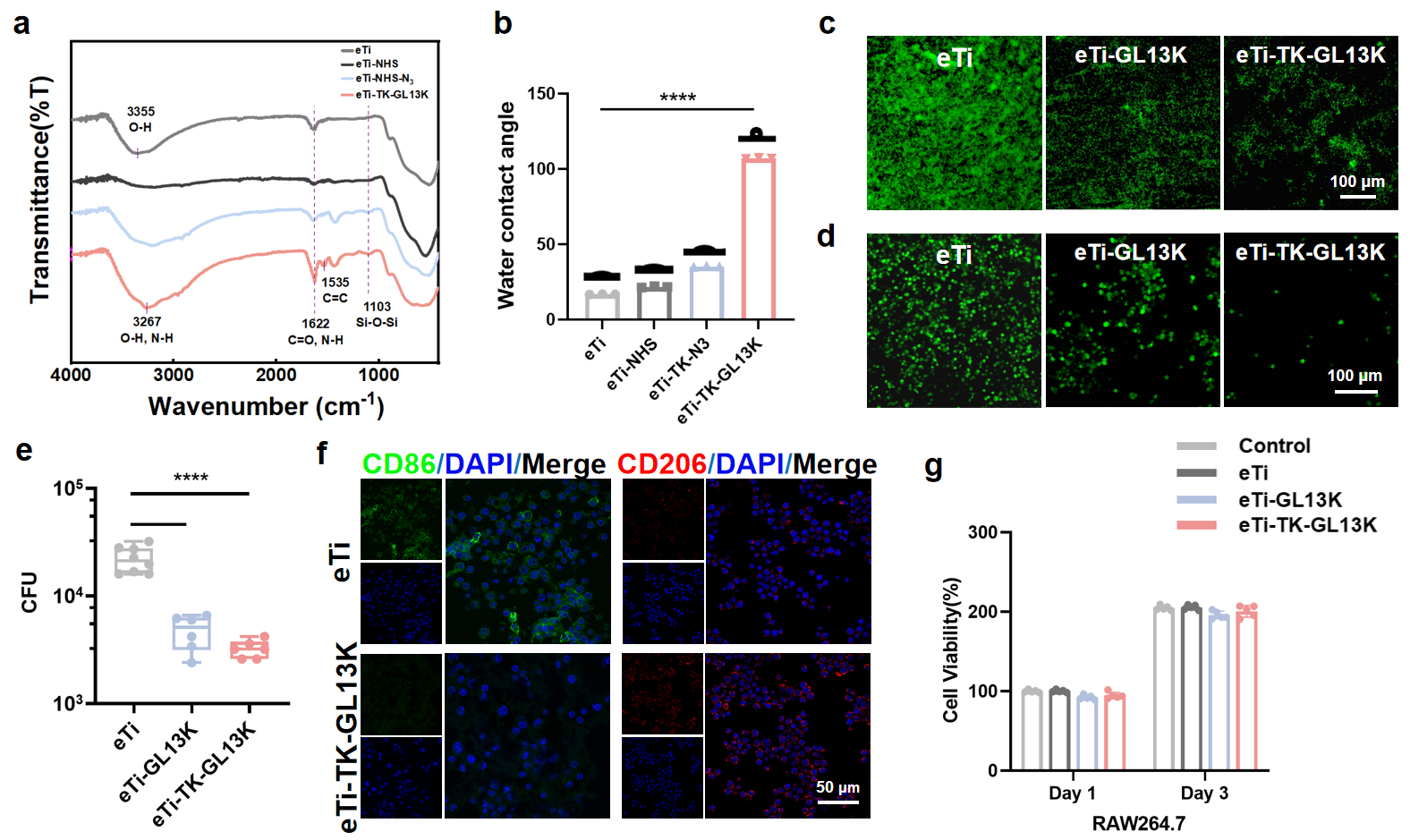IADR Abstract Archives
Smart ROS-Responsive Antimicrobial Peptide Coatings for Orthodontic Mini-Implants
Objectives: Orthodontic mini-implants loss is a global issue, with 30% of mini-implants failing due to infection. Persistent chronic inflammation maintains high reactive oxide species (ROS) levels, further hindering bone healing. To address this problem, we developed a smart ROS-responsive antimicrobial peptide GL13K coating (eTi-TK-GL13K) on mini-implants, endowing them with antibacterial properties. The ROS-responsive bond counteracted cellular oxidative stress, and responsively released the antimicrobial peptide GL13K, which has anti-inflammatory effects, providing an innovative solution for extending the service life of mini-implants.
Methods: The titanium surface was activated using acid etching and alkali etching, followed by stepwise grafting of Silane-PEG-NHS, N3-TK-PEG-NH2, and DBCO-GL13K under mild conditions to obtain eTi-TK-GL13K. The physicochemical properties of the coating were analyzed using infrared spectroscopy (FTIR) and water contact angle (WCA). The antibacterial effect of eTi-TK-GL13K against methicillin-resistant Staphylococcus aureus (MRSA) was tested using Live/Dead assays and colony-forming unit (CFU) counting. Its antioxidant effect was characterized using the DCFH-DA probe in mouse monocyte-macrophage leukemia cells (RAW 264.7) stimulated by lipopolysaccharide (LPS). Its anti-inflammatory effect was evaluated via immunofluorescence staining, which tested the polarization trend of RAW 264.7 cells towards M1 or M2 phenotypes. Biocompatibility was assessed using the CCK-8 assay with statistical analysis (one-way ANOVA with Tukey HSD test; p<0.05).
Results: The physicochemical properties showed that the hydrophobic eTi-TK-GL13K was synthesized successfully. Live/Dead assay and CFU indicated a significant reduction of bacteria on eTi-GL13K and eTi-TK-GL13K. DCFH-DA fluorescence staining indicated that eTi-TK-GL13 could scavenge intracellular ROS radicals. Immunofluorescence staining indicated that eTi-TK-GL13 inhibited the polarization of RAW 264.7 cells towards M1 type and promoted polarization towards M2 type, with no significant cytotoxicity to RAW 264.7 cells.
Conclusions: In summary, eTi-TK-GL13K could responsively release the antimicrobial peptide GL13K in response to ROS, endowing mini-implants with antibacterial, antioxidant and anti-inflammatory properties.
Methods: The titanium surface was activated using acid etching and alkali etching, followed by stepwise grafting of Silane-PEG-NHS, N3-TK-PEG-NH2, and DBCO-GL13K under mild conditions to obtain eTi-TK-GL13K. The physicochemical properties of the coating were analyzed using infrared spectroscopy (FTIR) and water contact angle (WCA). The antibacterial effect of eTi-TK-GL13K against methicillin-resistant Staphylococcus aureus (MRSA) was tested using Live/Dead assays and colony-forming unit (CFU) counting. Its antioxidant effect was characterized using the DCFH-DA probe in mouse monocyte-macrophage leukemia cells (RAW 264.7) stimulated by lipopolysaccharide (LPS). Its anti-inflammatory effect was evaluated via immunofluorescence staining, which tested the polarization trend of RAW 264.7 cells towards M1 or M2 phenotypes. Biocompatibility was assessed using the CCK-8 assay with statistical analysis (one-way ANOVA with Tukey HSD test; p<0.05).
Results: The physicochemical properties showed that the hydrophobic eTi-TK-GL13K was synthesized successfully. Live/Dead assay and CFU indicated a significant reduction of bacteria on eTi-GL13K and eTi-TK-GL13K. DCFH-DA fluorescence staining indicated that eTi-TK-GL13 could scavenge intracellular ROS radicals. Immunofluorescence staining indicated that eTi-TK-GL13 inhibited the polarization of RAW 264.7 cells towards M1 type and promoted polarization towards M2 type, with no significant cytotoxicity to RAW 264.7 cells.
Conclusions: In summary, eTi-TK-GL13K could responsively release the antimicrobial peptide GL13K in response to ROS, endowing mini-implants with antibacterial, antioxidant and anti-inflammatory properties.

